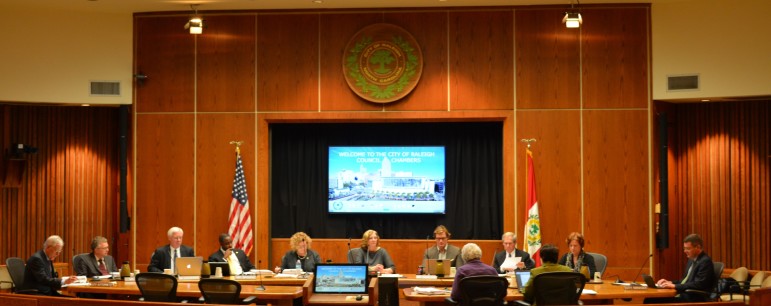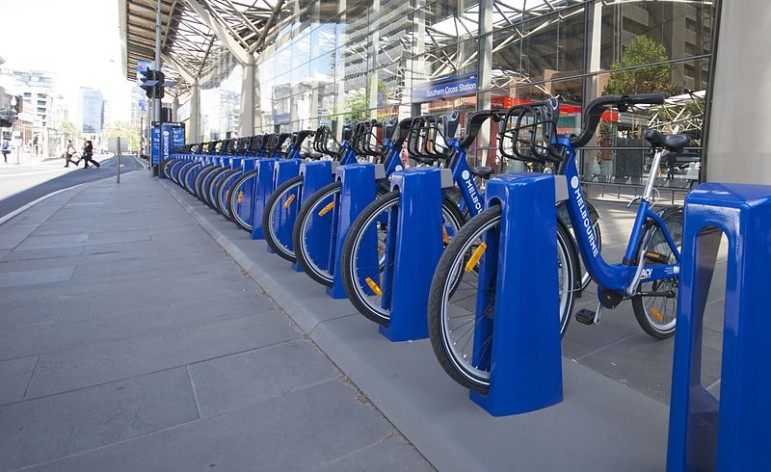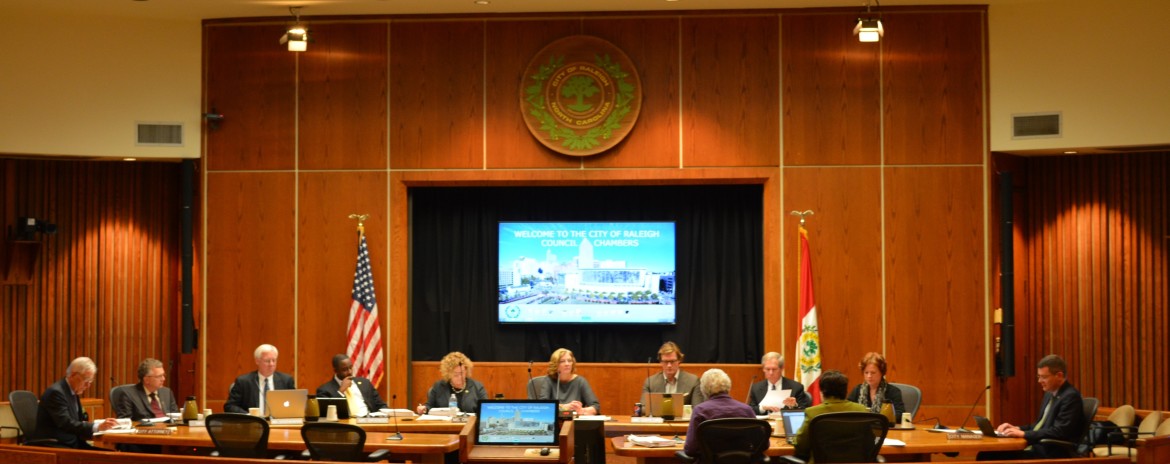Last week, we previewed what would be coming up at City Council with our Agenda Preview, an in-depth look at the issues scheduled for discussion before council. Today, we bring you The Council Record, an informal but nevertheless comprehensive look at the most recent City Council meeting.

March 15, 2016
As always, the Raleigh City Council meeting last week began with an invocation, led this time by Reverend Tom Harris of St. Andrew’s Presbyterian Church, and the Pledge of Allegiance, led by Councilor David Cox.
Presentations & Awards
Mayor McFarlane began last week’s meeting by declaring Saturday, March 19 as TEDx Raleigh Day.
“This is a local, self-organized event, it brings the community together to hare a powerful Ted-like experience that leads to deep discussion and connections. This year’s event sold out in minutes, it’ll be the largest and most influential TEDx Raleigh event ever!” McFarlane said.
Next up was a brief presentation announcing the 50th anniversary of local law firm Parker Poe, which has a long-standing tradition of community service in the city. Recently, the firm donated $2,500 toward the renovation of Moore Square, and $2,500 to the City of Raleigh Museum.
This was followed by a speech from Stacey Bluth from the Hope Center at Pullen. The Hope Center is currently serving 140 young people aged 13-25 who are at risk of or who have recently aged out of foster care.
“Just three years ago, we were serving only 12 young people,” Bluth said.
Touting the program’s successes, she noted that “90 percent of the young people in our program are housed stably, compared with 40 percent nationally; 65 percent are enrolled in secondary education vs. 8 percent nationally, 100 percent of the 24 year olds employed compared to 50 percent nationally.”
She thanked the City for its continued support of the program.
Consent Agenda
Only one item was pulled from the Consent Agenda, an encroachment request at 223 South West Street from Kane Realty. Councilor Bonner Gaylord requested that the item be pulled so he could recuse himself from voting on it. Gaylord is the General Manager at North Hills, which is owned by Kane Realty.
The entire consent agenda, including the encroachment request, was approved unanimously.
Report and Recommendation of the Planning Commission
The first item up for discussion from the Planning Commission was Z-27D-14, an amendment to the citywide remapping case approved in February. Certain properties were examined by City Staff and the Planning Commission to see if the remapping could be made less restrictive.
“We took each case independently, we have information from the applicants and we voted on each one independently,” Planning Commission Chairman Steven Schuster said.
Councilors voted to schedule a work session for Monday, March 28 at 4 p.m. to discuss the case further.
“I’m so excited because we haven’t had a UDO meeting in a while, we missed them!” joked Mayor McFarlane.
This was followed by a quick vote to schedule an April 5 public hearing for text change TC3-16, which deals with Historic Overlay Districts.
The next rezoning case was introduced to Council by Chaimrnan Schuster.
“I promised I would bring it back with no further extensions,” he said of Z-34-13, which has been under review since 2013 and will allow for a denser residential development along Hillsborough Street.
Councilors thanked Schuster for the commission’s work on the case, and he responded he was “happy to have this in your court.”
A public hearing was scheduled for April 5.
The final rezoning case was Z-46-15, which would rezone to industrial use a portion of land on West Lenoir Street. A public hearing was scheduled for April 5.
Special Items
At the March 1 meeting, Councilor Gaylord had asked that a request for a no-parking zone on St. Alban’s Drive be held so he could review the case further. At the March 15 meeting, he said the issues had been resolved and the request was approved unanimously.
Another road-related project was up next in the Special Items portion of the meeting, with Councilors receiving an update on the damages caused by the Leesville Road Widening Project, including Mr. Scott Benrube, who spoke at the March 1 Council Meeting.
Chris Johnson from the City said they had met with Mr. Benrube and agreed to have most of the issues resolved by the bonding company now handling the project. The only one the City will not deal with is a possible flooding concern, as any issues related to this existed on the property before the road widening.
The final special item was quite special indeed: Streetside Vending, specifically, Food Trucks.
The City’s Assistant Planning Director Travis Crane began by telling Council this had last come up at a public hearing in December, and spent some time in Council Committee. The decision was to establish a six-month pilot program in five different zones throughout the city, between the hours of 10 a.m. and 3 p.m., with an extension to 8 p.m. on First Fridays.

Crane said they had discussed a number of options for doling out those five permits, including a lottery system. Ultimately, however, it was determined that food trucks would not want to be tied to one location for an extended period of time. It was decided that it would ultimately be up to the property owners who had requested these food truck zones to contract out which food truck was using the space at any given time.
Councilor Mary Ann Baldwin provided some background on how these zones came to be.
“We didn’t create these locations,” she explained.
“These were locations that were requested by businesses and other entities, including the state government, so when we looked at this, we were responding to requests from the community.”
Baldwin also discussed how the vendors would be rotated out.
“Let’s say Citrix was managing the spot, they would contact different vendors from our list of preapproved vendors, so it would be in their best interest to have a variety, and not have the same person come there every day.”
Councilor Cox expressed concern over the noise level generated by food trucks, and Councilor Baldwin pointed out that with all of the construction taking place near the food truck zones, it would be difficult to determine how much noise the trucks themselves were contributing. It was ultimately decided that the noise issue would be re-examined at the end of the six-month trial period.
Under present code, the City cannot regulate noise in the right of way, where the trucks are located, although a new ordinance could be proposed to change this.
Crane told Councilors that they had worked with the Downtown Living Advocates to conduct a survey of residents living near these proposed locations. Only 14 responses were received, although they were mostly supportive of the food trucks. Respondents were split on whether they preferred that food trucks be dispersed throughout the city or gathered in one central location such as a Food Truck Rodeo.
The six-month pilot program was approved unanimously by Council.
City of Raleigh Bike Share
Although it was not on the agenda, Mayor McFarlane brought to the table an item Council had discussed in its earlier work session: the City of Raleigh Bike Share Program.
“I’m going to make a motion that we move forward with initiating bike share as presented in the feasibility study,” McFarlane said.
Councilor Kay Crowder expressed her reservations with the program.
“I think I should be clear, I don’t dislike bike share,” Crowder began.
“But as a city we have to make a lot of value judgments, many are hard and sometimes we can’t afford to do everything.”
“Many people in the city are broken and poor or homeless and downtrodden, there’s children without homes, there’s elderly people that need our help, and sometimes we’re the only voice they have, there’s so much to be done in the city and so little to get it done,” Crowder said.
“But $635,000 a year to maintain bike share, I think we could use that money in many ways to support many people.”
Councilor Stephenson responded that 80 percent of the capital costs would be covered by a grant, and they hoped that about 65 percent of the annual operating costs would be covered by sponsorships and rider fees.

Wikimedia Commons
A bike station in Melbourne, Australia
“At the end of the three-year period, either we’re not getting the sponsorship we want, and we re-evaluate whether it’s a good program to continue with, or we find plenty of sponsorships and that program is entirely self-supporting,” Stephenson said.
“If we don’t take this first step, we lose the two million and we won’t find out whether the program will support itself without taxpayer money.”
Other Councilors expressed their support for the project, with Councilor Branch saying he had gone back and forth on whether to approve it or not, but had ultimately decided it was worth giving it a shot. Councilor Baldwin said she agreed with the sentiments expressed by Crowder, and said it was something the City needed to be looking at constantly. It was a topic that would come up again in Baldwin’s report at the end of the meeting.
Ultimately, Councilors voted to approve funding the Bike Share program. Councilor Crowder cast the only dissenting vote.
Body-Worn Police Cameras
Following its lengthy discussion on Bike Share, Councilors quickly jumped into an even longer discourse on a much more serious issue: body cameras for Raleigh Police officers.
City Manager Ruffin Hall introduced the subject to Council, saying there were two primary policy questions that needed to be addressed.
“First, is the city going to move forward with body worn cameras for the Raleigh Police Department?” Hall said.
“If yes, then how do we implement this technology in the most effective matter?”
Hall went on to say that the subject of police body-worn cameras was “a complicated topic, not just within our own community but nationally, it’s something that’s gotten the attention of a lot of cities across the country.”
Hall then introduced Raleigh Police Chief Cassandra Deck-Brown, the City’s in-house expert on body-worn cameras.
Deck-Brown said she hoped to shed some light on the specifics of the technology and implementation of the body cameras.
“Basically, the technology is a video-recording system worn by an officer on his or her body in some capacity, it records the interactions between the officer and the public, and beyond just recording, it’s a multifaceted device,” Deck-Brown said.
Some of the potential upsides of implementing body-worn cameras for the Raleigh Police Department, she said, are potential reductions in citizen complaints, use of force by officers and officer and citizen injuries.
Darnell Smith, the City’s Chief Information Officer, delved into some of the tech specifications of the recording system.
“There’s a lot of players in this space, it’s seen as lucrative: businesses large and small, some are well-established, like Taster and Wolf, some are fly by night,” Smith said.
In addition to finding the right company to manage the system, Smith said, the City would have to decide on a preferred storage medium. They could either build and maintain a data retention center in-house, or have the data hosted elsewhere on a cloud server.

Wow, so this body camera is basically live-streaming me? How do I turn it off again?
Having the servers in-house would result in a larger upfront cost but lower overall operating costs, while cloud storage would not have a similar upfront cost and would allow for more flexibility in terms of how much data the City wished to store.
Deck-Brown said they were recommending the cloud-based system as a storage medium and a three-year phased implementation as the process, with 100 cameras in the first year and an additional 250 in the second and third, for a total of 600 body-worn cameras.
The cost over that three year period, she said, was estimated at between $4.2 and $5 million, with $1-1.2 million being spent in the first year.
Ancillary costs for certain equipment and other peripherals such as docking stations would run about $540,000, and three additional staff would need to be hired at a cost of around $170,000.
One other goal of the system would be to upgrade the in-car cameras, which could potentially be linked with the new body-worn cameras.
The goal, Deck-Brown said, was to issue the RFP some time in the fourth quarter of FY2016, which would mean sometime between May and June 2016. They hope to reach a final decision by the second quarter of FY2017, which would be sometime between October and December of 2016.
“I’ve seen computers enter police cars; we went from pagers to smartphones, Tasers were added since I’ve been here,” said Chief Deck-Brown, who began her career with the RPD as a patrol officer in 1987.
“When I arrived there were revolvers, and now law enforcement across the nation uses semi-automatic weapons. Body-worn cameras are one of the newest forms of technology; all of the changes reflect an evolution of policing.
“I see it as a technology that affords us a better opportunity to not only police, but to build upon the expectations I mentioned earlier.
“We are the capital city, and now is the time,” she finished.
Councilor Mary-Ann Baldwin asked whether any consideration would be given to local companies for data storage, such as Citrix. Chief Information Officer Smith said they had not gotten to that point yet, and noted that any hosting company they did go with would have to be certified to host law enforcement content.
Baldwin requested that the possibility of using a local firm be taken under consideration during the RFP process, and the Council soon authorized staff to move forward with the RFP for a body-worn camera system for RPD.
Report of the City Manager
Technically, the presentation on body-worn cameras was part of the City Manager’s report, but it was so long we figured it deserved its own section.
The second item on the City Manager’s report was an update on Dix Park, with a presentation from Kate Pearce from the City’s Parks, Recreation and Cultural Resources department.
“All great cities have great parks and public spaces,” Pearce began.
“Raleigh’s no different: more than 10 acres of parks, more than a hundred miles of greenway, nine outdoor and indoor pools. Then Council made the bold decision to acquire Dix — I consider that the crown jewel of the park system,” she said.
Pearce went through a number of similar projects throughout the country, some of which, like Dix, transitioned from a non-public use to a public use.
“Governor’s Island in New York is a former military fort and coast guard station, it’s a 200 acre island out in middle of New York’s bay,” she said.
“It’s a non-public use becoming public use, and it’s been extraordinarily successful.”
The Dix property currently has four tenants leasing space from the City, the State Department of Health and Human Services, which has a ten and a 25-year lease on some of the buildings, Healing Transitions, which has a 25-year lease on ten acres, Bright Horizons, a day care run by NC State, which has three acres, and the Capital Area Soccer League Bright Horizons and the Capital Area Soccer League, which uses some of the fields.

Pearce said they were looking forward to initiating the master planning process, which would begin with community engagement and discussions.
“We’ll get people inspired, excited about what this can be, and work with groups throughout the community,” she said.
The community engagement will occur throughout the remainder of this year, with a contract for master planning services awarded sometime in 2017, Pearce said.
Next up was a request to move forward with about two miles worth of sidewalk repairs first outlined in 2014. The work will occur along Crabtree Boulevard, Spring Forest Road, Millbrook Road and New Hope Road. Council moved quickly for approval.
The final item from the City Manager was a reorganizational realignment of the City’s public works department. It would essentially split the department into an engineering services and a transportation department. Councilors voted unanimously to approve the realignment.
Comments and Petitions of Citizens
The first person signed up to speak at the March 15 meeting was absent, and the next two were simple requests for extensions on renovation projects, so let’s skip right to the third item: the relocation of 12 graves from the Williams Grove Cemetery to Oakwood Cemetery.
Council’s approval of this request was essentially a formality; all the necessary procedures and processes required for such an endeavor has already been undertaken. Nonetheless, several of them took an interest in the matter, inquiring as to the possibility of relocating the graves within the Williams Grove Cemetery, and whether the Oakwood Cemetery would accept these graves.
The request was approved.
The final speaker actually gave her presentation a little later in the meeting, but for the sake of organization, we’ll include it here. Trisha Elliot from Targeted Persuasion was on hand to speak about Raleigh’s many talented female chefs and restaurateurs.
She was accompanied by Maggie Kane, formerly of Hope Wins Ministries, who is now the executive director for a Place at the Table, a pay-what-you-can restaurant concept they hope to open early next year. Although a location has not yet been selected, Kane said that Hillsborough Street would be ideal.
A Place at the Table will be having a pop-up event on April 2nd from 11 a.m. — 2 p.m. at Solas on Glenwood Avenue.
Public Hearings
The first public hearing at Council’s March 15 meeting was for the demolition of a property at 5411 Allen Drive, an unkempt and poorly maintained residence that had been a source of much aggravation for the surrounding neighborhood.
Some of those neighbors were on hand to speak, saying that squatters had lived in the house for a time with no running water or sewage, followed by “men on motorcycles” who expressed interest in turning the home into a motorcycle club. Unfortunately, local zoning did not allow for this, and the motorcycle man elected to partake in unpermitted renovations to the house instead. After being told twice by the City to stop, work finally ceased and they finally moved along.
One neighbor said he had arranged to buy the property from its actual owner, someone in California who has never been out to see the house. The neighbor plans on tearing it down, but asked Council to authorize the demolition in case he was not able to acquire the property in a timely fashion. If he gets it by the first of April, the timetable for demolition will be much shorter than if it is done by the City.
Councilors voted unanimously to approve the demolition.
The next property, at 106 Colleton Road, was approved unanimously for demolition with almost no discussion.
A number of properties were declared public nuisances and Council authorized fining the owners.
The final public hearing dealt with a water assessment for a state-owned property on Edwards Mill Road. Council agreed to correct a previous assessment and reapportion the fees.
Committee and Councilor Reports
The only committee report March 15 came from the Growth and Natural Resources Committee, which recommended scheduling an April 5 public hearing for Z-39-15, a rezoning case on Trailwood Drive.
Mayor McFarlane said the St. Patrick’s Day Parade was a “blast” and thanked everyone who helped put it together.
Councilor Gaylord said he had learned of training offered by the National Association of Mental Illness to public safety officers for dealing with the mentally ill.
Councilor Baldwin, who earlier in the meeting expressed an interest in doing more for the City’s less fortunate, brought up a machine she had seen recently in the Denver airport, which allowed people to donate their spare change to an organization helping the homeless.
The program had raised $170,000, Baldwin said, and she believed something similar could be a success in Raleigh, perhaps by setting up one at the airport and one downtown. Staff will look into the issue.
Closed Session
Councilors then entered a closed session, where they discussed the acquisition of a property under the City’s Watershed Protection Program and jury recommendations for the annual environmental awards.
